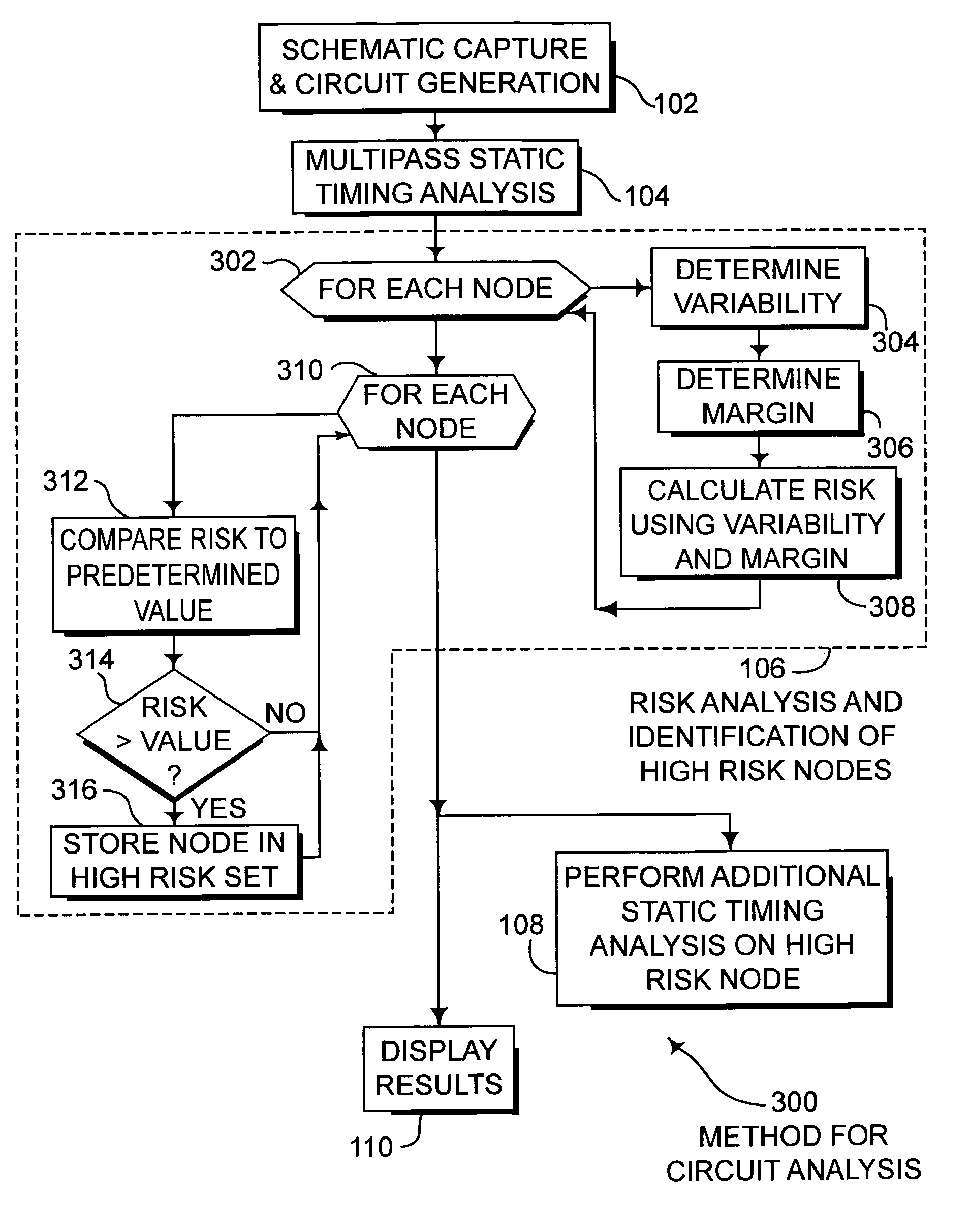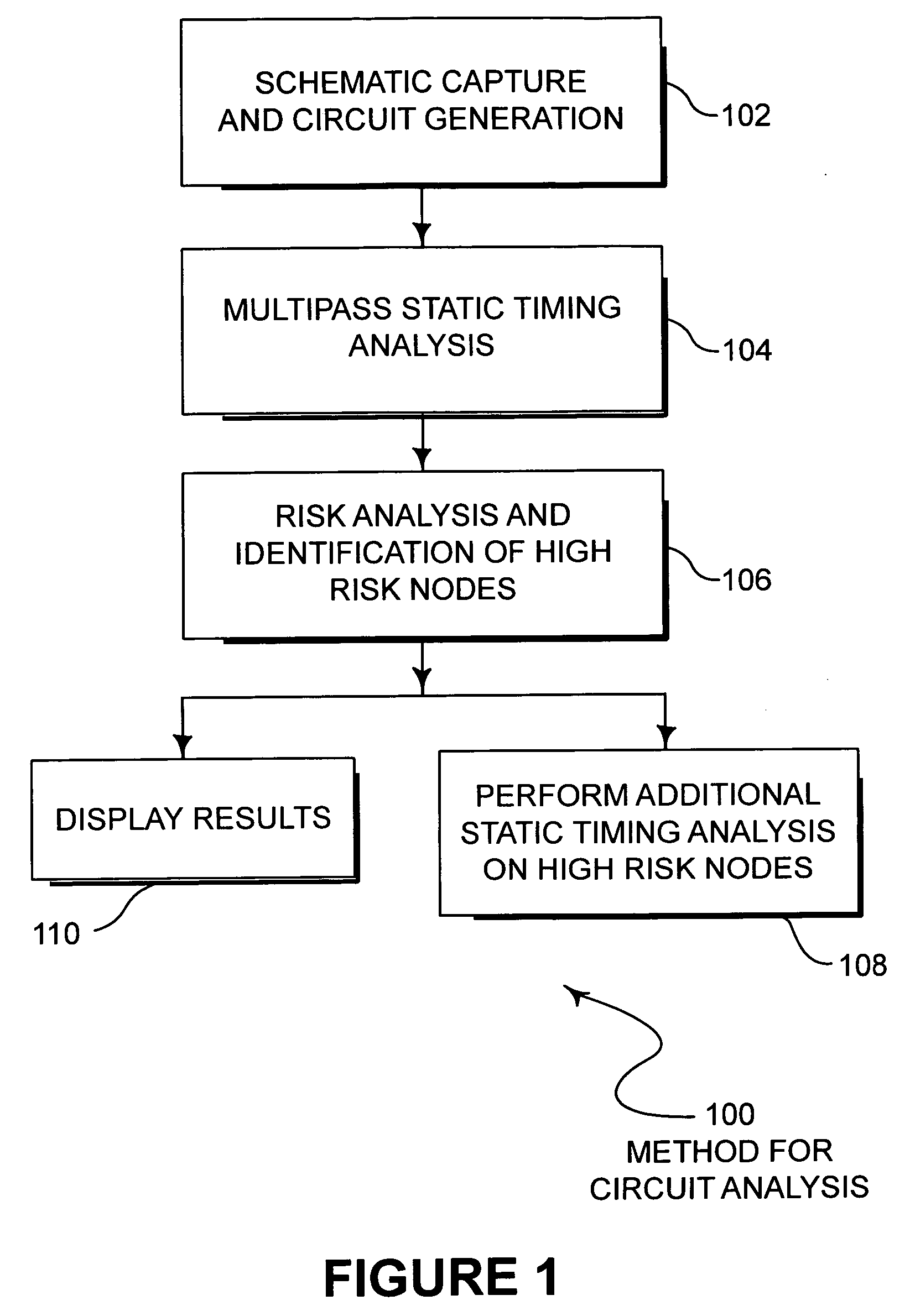Static timing and risk analysis tool
a technology of risk analysis and integrated circuits, applied in the field of integrated circuit tools, can solve the problems of affecting the quality of integrated circuits, affecting the accuracy of integrated circuits, and containing an enormous number of components or cells, and achieving the effect of eliminating costly and frustrating failure analysis and high quality
- Summary
- Abstract
- Description
- Claims
- Application Information
AI Technical Summary
Benefits of technology
Problems solved by technology
Method used
Image
Examples
embodiment 100
[0030]FIG. 1 is a flowchart illustration of an embodiment 100 showing a method for analyzing a complex circuit, such as an integrated circuit (IC). The schematic capture and circuit generation is performed in block 102, followed by a multipass static timing analysis step in block 104. The results of the multipass static timing analysis of block 104 are used in the risk analysis and identification of high risk nodes of block 106. After risk analysis, additional static timing analyses may be performed on the high risk nodes in block 108 or the results may be displayed in block 110.
[0031]Embodiment 100 is a method of analyzing a complex integrated circuit or similar electrical circuit by performing static timing analysis using at least two corner cases, screen the nodes based on a risk factor, and then perform additional analyses on the high risk nodes. The complexity of a circuit may be such that performing one corner case analysis may require several hours or even days of computer ti...
embodiment 200
[0043]FIG. 2 is a flowchart illustration of an embodiment 200 of a method for analyzing a complex circuit, particularly detailing a multipass static timing analysis method. The circuit is designed using a schematic capture and circuit generation tool in block 102. Within the multipass static timing analysis block 104, the corner cases for the analysis are defined in block 202. The static timing analysis is performed using one of the corner cases in block 204, the results of which are saved in block 206. If another corner case needs to be run in block 208, the process continues with block 204. If no other corner cases need to be run in block 208, all of the analysis results are aggregated in block 210 and saved in block 212. The results of the multipass static timing analysis block 104 are processed for risk analysis in block 106. The risk analysis results may be used to perform additional static timing analysis in block 108 or may be displayed in block 110.
[0044]The multipass static...
embodiment 300
[0048]FIG. 3 is a flowchart illustration of an embodiment 300 showing a method for circuit analysis with a detailed illustration of the risk analysis and identification of high risk nodes. The circuit is created and defined in the schematic capture and circuit generation block 102. The multipass static timing analysis is performed in block 104. Within the risk analysis block 106, for each node in block 302, the variability of each parameter is determined in block 304, the margin is determined in block 306, and the risk is calculated in block 308. For each node in block 310, the risk is compared to a predetermined value in block 312. If the risk is greater than the value in block 314, the node is stored in a high risk set in block 316. After all the nodes are processed, additional static timing analysis may be performed in block 108 on the subset of nodes defined as high risk in 316 and the results may be displayed in block 110.
[0049]The embodiment 300 illustrates a method whereby a ...
PUM
 Login to View More
Login to View More Abstract
Description
Claims
Application Information
 Login to View More
Login to View More - R&D
- Intellectual Property
- Life Sciences
- Materials
- Tech Scout
- Unparalleled Data Quality
- Higher Quality Content
- 60% Fewer Hallucinations
Browse by: Latest US Patents, China's latest patents, Technical Efficacy Thesaurus, Application Domain, Technology Topic, Popular Technical Reports.
© 2025 PatSnap. All rights reserved.Legal|Privacy policy|Modern Slavery Act Transparency Statement|Sitemap|About US| Contact US: help@patsnap.com



